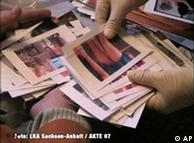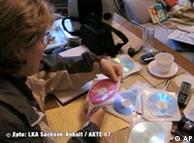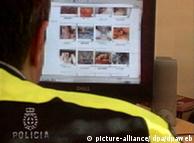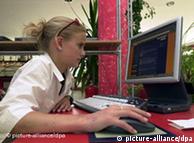d.welle Internet Home to Most Child Sex Crimes, Expert Says
rime | 20.09.2007
Internet Home to Most Child Sex Crimes, Expert Says
Ahead of a conference aimed at combating the sexual exploitation of children on the Internet, DW-WORLD.DE spoke to a German police investigator who used creative methods to crack a child pornography ring.
On Thursday, Sept. 20, the Organization for Security and Cooperation in Europe (OSCE) is holding an international conference on the topic of combating sexual exploitation of children on the Internet. The meeting aims to address the obstacles involved in investigating this growing category of crime, whose creators, providers and users are often scattered around the globe. Bildunterschrift: Meyer's "Operation Mikado" brought together police and credit card firms
Bildunterschrift: Meyer's "Operation Mikado" brought together police and credit card firms
DW-WORLD.DE spoke with Torsten Meyer, the chief investigator in the eastern German state of Saxony-Anhalt and an expert in the area of child sexual abuse. Earlier this year, Meyer made headlines when he successfully cracked a child-pornography ring by analyzing credit card data. His "Operation Mikado" located over 300 criminals who paid to access what Meyer called "seriously hardcore" images on the Internet.
Mikado -- the German name for the game "Pick-Up Sticks" -- is an apt metaphor for the investigation as sorting through the data was a delicate act, Meyer said.
"We had to be careful to pick the criminals out, from this huge pile of information, one by one, without touching the others," he said.
DW-WORLD.DE: Over the years there has been a lot of talk about how the Internet gives those interested in child pornography a platform to organize themselves and communicate with one another. How important is the Internet for these criminals?
Torsten Meyer: The majority of crimes in this area are found on the Internet. … With the data possibilities, criminals in many areas, but especially pedophiles, have the possibility to meet up, exchange ideas, and get their hands on much more material. Back when data networks were less developed, it was harder for them.
But I have to make one thing clear: Child pornography and pedophilia have always existed. The Internet just makes it easier for them to create pornography. That goes for other technologies, like digital cameras, digital video cameras. Anything with a large memory capacity can be used to make child pornography easily and quickly.
Where did you get the idea for Operation Mikado? The examination of private credit card data was seen as quite controversial in terms of data privacy.
 Bildunterschrift: Großansicht des Bildes mit der Bildunterschrift: The credit card analysis caught some 300 child porn users
Bildunterschrift: Großansicht des Bildes mit der Bildunterschrift: The credit card analysis caught some 300 child porn users
Last year we got a tip from a reporter at a TV station, who told us about a child pornography site. On the site it said that if you paid $79.99 (57.67 euros) you could get access to a members' area. Once you had access to the membership area you had 3-4 gigabytes of seriously hardcore child pornography.
During the investigation the German credit card companies agreed to provide us with names of the people who met five specific criteria: an exact amount that was charged, a specific use named for the charge, which bank the payment was made to, a specific identification number, and a very limited time frame. So we could be fairly certain that only the people who were named to us had paid to enter into this special membership area.
In the end, we got around 322 suspects' names, and could investigate them further. And in fact, almost all of the people were correctly identified as users of child pornography.
What became of those suspects?
They were investigated by state authorities, who confiscated PCs, laptops, and hard drives. These were analyzed, or still are being analyzed. The information went to state prosecutors, who decide whether to prosecute, or perhaps to levy a fine.
What exactly made this process so different from other investigations into child pornography?
 Bildunterschrift: Großansicht des Bildes mit der Bildunterschrift: Credit card companies gave police a list of potential customers of child porn
Bildunterschrift: Großansicht des Bildes mit der Bildunterschrift: Credit card companies gave police a list of potential customers of child porn
The decisive difference here is that German credit card companies agreed to help us. A few years earlier they had agreed to a code of conduct that said, essentially, "Our credit cards should not be used to for criminal activity, especially not for crimes like child pornography. And we will do all we can to fight this." So we took them at their word.
Moreover, I have to make clear it was the credit card companies that examined the data, not the police. We were only given the information of the 322 who met those five very limited criteria.
Do you know why this method hasn't been used before?
I don’t know. For us, we suddenly had this case, and we said, OK, let's do it this way. But why no one else had done it, I can't say.
Could a case like this actually be the first-and-last of its kind? Wouldn't knowledge of this method just make vendors and users of child pornography more careful about hiding their paper trail?
From the point of view of law enforcement agencies, you don’t have to worry about that. There are a lot of ways to investigate these criminals, even if they find other ways to conspire.
Is there any one development in child pornography that is seen as particularly dangerous right now? Bildunterschrift: Großansicht des Bildes mit der Bildunterschrift: The UK's Internet Watch Foundation said child porn images have increased 1,500 percent since 1997
Bildunterschrift: Großansicht des Bildes mit der Bildunterschrift: The UK's Internet Watch Foundation said child porn images have increased 1,500 percent since 1997
The key is to know that child pornography is the representation, the embodiment, of the sexual abuse of children. For something to be considered child pornography, it involves the sexual portrayal of a child -- that is, according to German law, a person under age 14.
The biggest danger is that there is a market, in Germany and worldwide, for materials that portray this. And that there are sometimes even organized groups who exploit these markets and make child pornography to sell to them.
Where does the material filling the market come from?
Sometimes it was made in very poor countries, like for example in Latin America, Southeast Asia or Eastern Europe. Countries where children's rights may not be as highly valued as here in Germany. The families are very poor, they have eight to 10 kids. They don't know how they can manage from one day to the next. And the child is then sold to sex criminals who film their acts and sometimes go on to sell these images.
Are there certain areas within Europe where the problems are greatest?
 Bildunterschrift: Großansicht des Bildes mit der Bildunterschrift: International cooperation is crucial in identifying perpetrators and sexual exploitation victims
Bildunterschrift: Großansicht des Bildes mit der Bildunterschrift: International cooperation is crucial in identifying perpetrators and sexual exploitation victims
No, there is no part of Europe that is particularly more active than another. Everyone is equally affected by this.
Do European countries and agencies work well together on this issue? How can international cooperation be improved?
In recent years, a number of different measures against child pornography were undertaken, and various alliances and groups were formed. For example at Interpol in Lyon or Europol in The Hague. Also there is a tight connection between central German organizations, like the Federal Criminal Police (BKA), and their counterparts in London or Paris. And then, there are regular international conferences to discuss experiences and share information.
Of course, it could all be improved upon. But politicians are working on it, trying to harmonize certain things. Like the laws in various countries. Every country doesn't apply the same laws to child sex offenses. So in Europe -- and worldwide -- they still have to make some changes.
Where is the need for change the greatest?
At this point, the problem is recognized around the world. A decade ago, there were some countries where you couldn't really talk openly about the topic at all. But now this has changed. People recognize something must be done. And I see that people are working very hard to protect children. That's what the goal of this work really is: to scare off potential child pornographers and protect children.
Can individuals do anything to protect their children from becoming victims of Internet related sex abuse?
 Bildunterschrift: Großansicht des Bildes mit der Bildunterschrift: Children in chat rooms can become prey for sex predators
Bildunterschrift: Großansicht des Bildes mit der Bildunterschrift: Children in chat rooms can become prey for sex predators
It is very important that parents and teachers learn how to use the media. Many teachers and parents just throw up their hands and say, "I don't know how to use this; you do it." They leave it up to the child to use the media. So the children wind up in chat rooms where they think they are chatting with people of their own age. But there are actually a lot of men there who are much older. They claim to be young. They make dates to meet, exchange phone numbers. And then the date turns out to be a sexual assault.
Teachers and parents really need to be aware of this. There are too many people who still don't know about it. They should keep an eye on who their children know, who they are meeting, where and when.

Comments